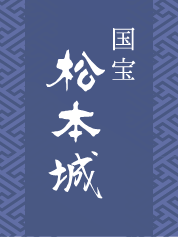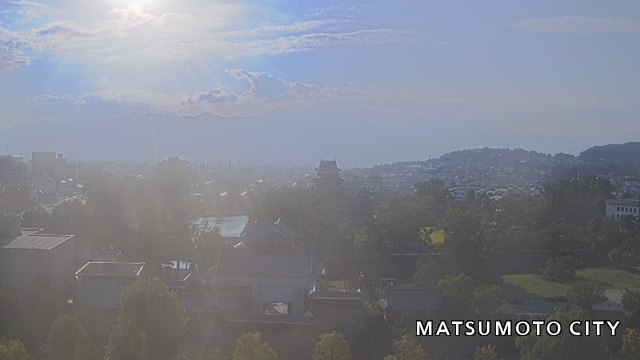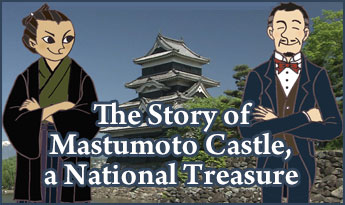Other points of interest
Relief images of Ichikawa Ryozo and Kobayashi Unari

In your left is Ichikawa Ryozo, and on your right is Kobayashi Unari, both of them made a great effort to preserve the Matsumoto Castle, in the Meiji Period and later.
On January 1872, the Matsumoto Castle was put up for auction, and an individual won the bid at a price of 235 ryo, 1 bu ei, 150 mon. "Ei" is referred to as "Sen". Being aware of it, volunteers led by Ichikawa Ryozo who was Shimoyokota Town Vice Administration Officer (merchant and free civil right activist) stood up and held expositions in the Matsumoto Castle, primarily in the Keep on 5 separate occasions. They successfully repurchased the Keep using the revenues and donations. Ichikawa's petitions asking for permission to "use the Keep of the Matsumoto Castle for Expos" addressed to Chikuma Prefecture Officer have been preserved in a frame, on the 6th floor, western part of the Keep.
Kobayashi Unari was born as a son of the elder in the Hakata domain in Senshu (present day Osaka) and served as principal of the Matsumoto junior high school between 1885-1914. He was a key person of the Meiji Great Repair Project. In 1901, where wear and tears and inclination of the Keep became significant, he organized the Matsumoto Keep Preservation Society, which managed to collect donations amounting to approximately 20,000 yen from people throughout the nation.
Mizuno Tadanao consecration lantern

This lantern was donated to the Matsumoto Castle on October 21, 1953 by a person originated from Matsumoto after he purchased it at an auction following an organization of the properties within the Tokyo Ueno Kaneiji Temple.
Originally, it was dedicated to the Kaneiji Temple by the head of the Matsumoto domain, Mizuno Tadanao, to commemorate the 4th Shogun Ietsuna.
On the front facet of the lantern, the letters that read "To Genyuin", which is the posthumous Buddhist name of Ietsuna.
Followed by the donated date, "May 8, 1681".
Donated by "Shinshu Matsumoto Castle Lord Mizuno Tadanao".
Toda clan's lanterns


3 stone lanterns and 1 hand-wash basin were donated by Toda. It has been believed that they were originally placed in the Edo mansion of the Toda Clan. 1 lantern and the hand-wash basin are placed in the north-east corner of the Honmaru garden/the south side of the Kitauragomon, and 2 stone lanterns are placed in the west of the stone lanterns associated with the Mizuno clan.
Ogasawara peony

When Ogasawara Nagatoki was leaving Matsumoto being overthrown by Takeda Shingen, he reportedly entrusted a peony tree to the chief priest of the Tosenji Temple in Yamabe, which was transplanted and cared affectionately by a parishioner Kuneshita family as "white peony of lord" .
In 1957, the tree was given to Ogasawara Tadamune, an Ogasawara descendant, which was later transplanted in the Castle. Also, in 2006, some of the trees were donated by Kuneshita family. Now a total of 6 trees have produced beautiful white flowers in May every year.
Cherry tree to which a horse was tied

There is a cherry tree to which it has been told Kato Kiyomasa tied his horse when he visited the Matsumoto Castle. There is a lore that there was an old tree inside the castle, which was called "Cherry trees to which a horse was tied" or "Palace cherry tree". Between the 1962 and 1967, a young tree was planted in the current location, and grew up to what it is now.
Boshin War Troops Memorial Monument

The monument was built in 1904.
On 29 February 1868, the Matsumoto domain decided the attribution to the new government, and joined the government forces. It sent its troops to Utsunomiya, Hokuetsu and Aizu. On the facet of the monument, the state of the battle, and on the back of the monument, the names of the 261 soldiers have been carved. Epitaph was produced by Saga Sanenaru (Oogimachi) and Okada Masayoshi, a samurai clan. Gypsum was Seikisen.
Kosanji Goten (Palace) ruins


It has been said that when Ishikawa Kazumasa ruled the Matsumoto Castle, he built the Kosanji Palace to relax. Initially, it was written as "箇山寺(read as kosanji)" (named after part of Ishikawa Kazumasa's Buddhist name), and later re-named to 古山寺 (read as Kosanji) during the Mizuno clan era. During the Toda clan era, it was written 古山地 (read as kosanji), which became the unique name of this land.
This palace had a floor area of approximately 587 square meters, contained 30 rooms, which is only a quarter of the size of the Keep. So, it was small in size comparing with the Keep and the Ninomaru Palace. The illustration produced around 1712 shows that there was a tiny garden in the central part of the building, there were rooms in the south, and a kitchen in the north. At the southwest end of the palace, there was a bathroom, and at the northeast end, there was a Sukiya (tea room). Further at the west side of the palace, there were 10 "hawk rooms" . There were also bird huts called "Niwako" Inside the bathroom, there was an enclosure as big as 1.8 m by 1.8m on the center. It has been believed that it was a steam bath chamber. It is divided into two in the middle, the other side was a Kamaya (stove). As such there were private areas in the palace. The name "Imi Dokoro" means a place for comfort or relaxation. Therefore, it has been believed that this place was not a place to perform administrative affairs. Rather, it was a private living space of the lord. Toda who lost the Keep in 1727 by fire expanded this palace to build a new palace.
Wakamiya Hachiman Ruins

In 1504, Shimadachi Ukon Jōei moved his base from the Ikawa Castle to the current Matsumoto Castle, and named it Fukashi Castle. It has been told that after Shimadachi Ukon died in 1517, his son, Shimadachi Shichizo built a shrine in the castle to commemorate his father as the guardian deity of the Fukashi Castle.
Ogasawara worshiped Inari, while Mizuno worshiped Kanda Myojin here. It has been told that when a shrine located in Sansai in Tsukuma district was damaged, Mizuno Tadanao moved the shrine placed in Wakamiya Hachiman to Sansai to replace it. Until now, the building remains in Sansai district, which is designated as an important cultural asset having a Muromachi period architectural style.
To a little bit south of the Wakamiya Hachiman ruins, and to the north of Uzuhashi district, there is a fence called Ashida fence. To the south of this fence, there was a section called Ninomaru, which is adjacent to the Sannomaru section.
Photos of the member castles of the National Castle Administrator Council

In the south side of the Keep garden, photos of Japan's castles that are member of the National Castle Administrator Council have been displayed. Besides photos, various information on each castle is provided, including castle name, location, alias, types of the castle, founder, fortification year, and others.








